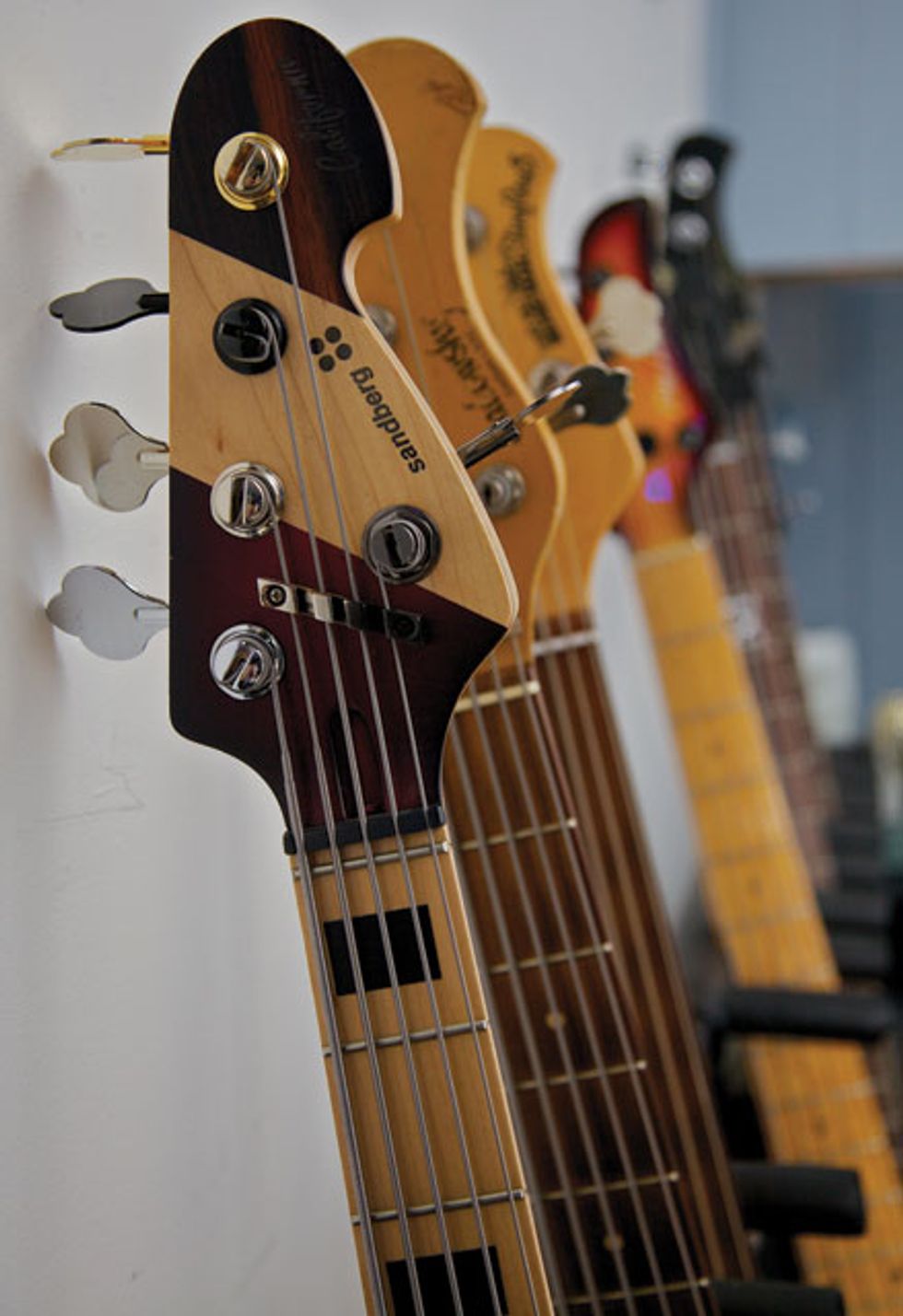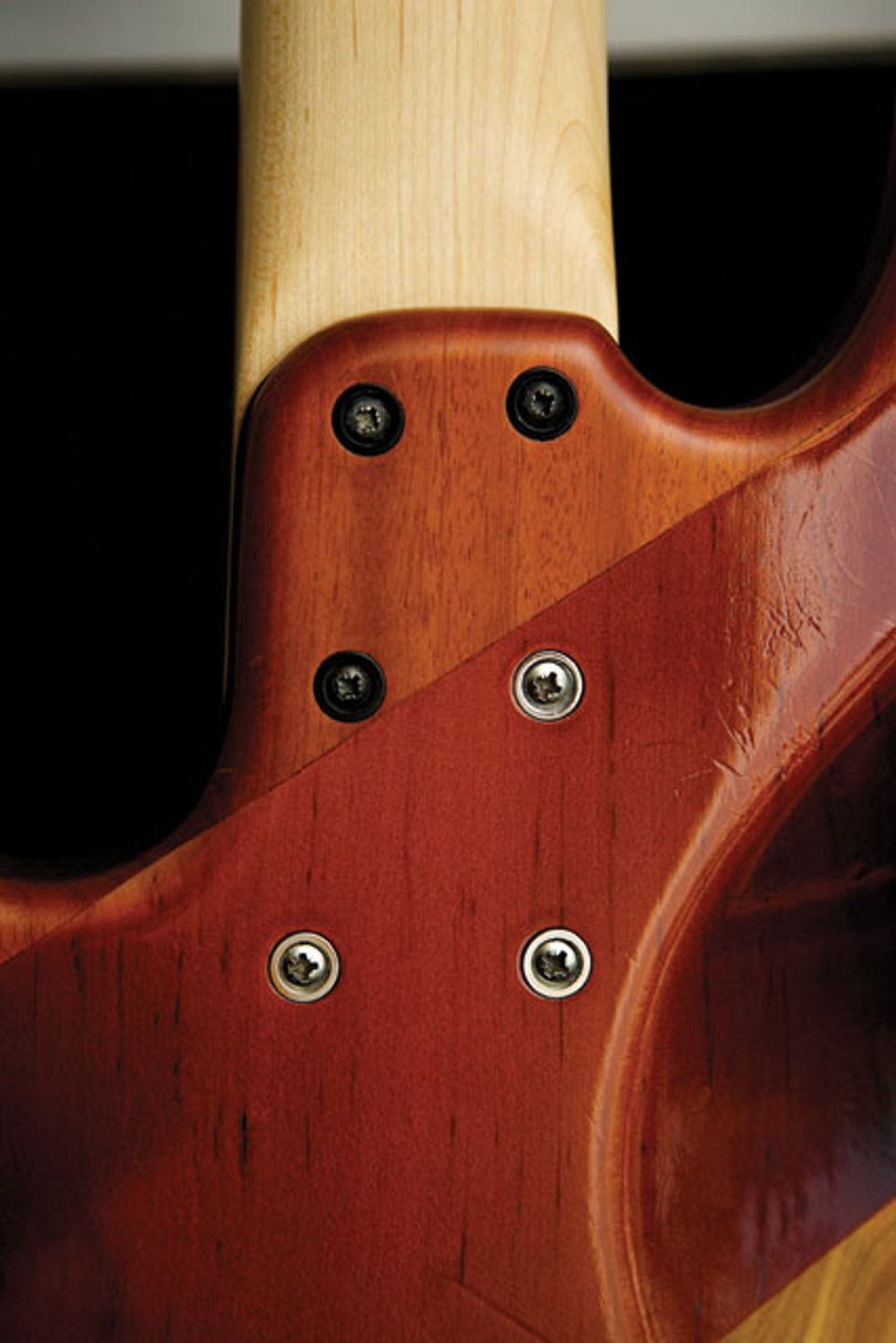You have to try many different basses to find one that is truly even, which is a more involved quest than tone alone.
One piece of advice I’m often asked for from producer and musician friends—those who don’t call the bass their instrument—is what to look for in their first “recording” bass. They’re usually at a point where they’re recording bass for projects themselves fairly often, and don’t necessarily need the expertise of a pro bassist. It’s definitely not a simple answer because there are so many things to keep in mind when shopping for a bass—be it fretboard wood, body wood, pickup combination, body style, electronics, or type of finish. I might come back to some of these considerations in future columns, but this month I want to discuss the thing I obsess over the most when bass shopping. Yes, you can change pickups in a newly purchased bass to alter the tone, you can switch out the bridge to improve sustain, and you can use a different set of strings to liven up a tired-sounding instrument. But you can’t make a bass that isn’t tonally consistent become even.
When looking for a bass, the most important question for me isn’t if the instrument sounds great. It’s if it sounds even. What I do is check to see if the 3rd and 4th strings have a lot of low end, but often the 1st and 2nd strings sound more like a guitar than a bass. This syndrome is my biggest pet peeve and it’s prevalent in four out of five basses on average. What’s interesting is that the problem is equally prevalent in every price range. In fact, I’d even say that it’s more common in what I call “furniture” basses—those instruments with super high-end preamps and electronics, exotic woods, and outlandish price tags. I find that these basses in particular have astounding tightness in the low register, but often a thinner, totally different quality on their upper strings. This simply doesn’t work for me and I always steer my friends away from instruments that possess this quality. These instruments just don’t provide enough evenness for bassists playing mainstream pop, rock, soul, or R&B on a day-to-day basis.
To test a bass for evenness, I’ll start by putting my ear to the side of its body to feel the vibrations of the instrument when played acoustically. In my opinion, monitoring the wood by ear with this method is the most effective way to hear the resonance of a bass. After it passes the unplugged test, I’ll see how much low end the bass puts out at a modest volume through a smaller amplifier. Using a larger amp at a louder volume for this purpose may amplify particular notes and make them too loud, thereby misrepresenting the true nature of the bass.
A solid neck/body joint is key for sustain and evenness.
Short-scale basses tend to have more evenness between the thicker strings and thinner strings, but these basses have a different set of tonal limitations for particular applications. Halfwound or flatwound strings can sometimes warm up a bass with a thinner upper register, but like short-scale basses, these types of strings have tonal limitations as well. One of the main benefits of having an even bass—where volume and low end is consistent from string-to-string and note-to-note—is that I am not dependent on compression as much. If your bass is truly even, it will never drop out of the mix, even if your bass line moves a lot. So if you go up into a higher register to play a lick, the other guys in the band won’t turn around wondering where the bassist went. It’s not a good feeling when you go for a fill or step out on a limb musically, but at the same time feel that you aren’t holding down the bottom end.
Dead notes are the last piece of the evenness puzzle. Most Fender-style, long-scale basses constructed from wood have a less-resonant spot on the 7th fret of the 1st string. This dead spot is almost impossible to get rid of completely, but you can look for a bass where the problem isn’t quite as obvious. Another notoriously common spot for deadness is the 10th fret of the 2nd string. This particular spot isn’t quite as common as the aforementioned location on the 1st string, but it certainly helps knowing about it.
There’s one more spot you should know about that’s known for delivering notes that are less fat or resonant, and it’s located at the first four frets on the 3rd string of a 35"-scale, 5-string bass. The obvious benefit of having a 35"-scale length is the higher tension on the 5th string, but the trade-off here is that four of the most important, “moneymaking” notes are slightly less full with many instruments in this category. You can hear it with some extensive testing, and this issue is more obvious through a large PA or a big rig onstage.
I’ve encountered tremendous evenness on basses that cost very little money. Because they were even, I’ve also purchased basses in colors I didn’t necessarily like or made out of woods with tonal qualities I normally don’t prefer. Evenness matters more than if a bass is a Jazz or a Precision. It even matters more than what string brand you use (and it’s common knowledge that I’m a stickler for a specific kind of string). If you have the time and patience to sit down and really listen to a bass before purchasing it, it will keep rewarding you with a feeling of fullness and authority … no matter where your fingers are on the fretboard.









![Rig Rundown: AFI [2025]](https://www.premierguitar.com/media-library/youtube.jpg?id=62064741&width=1245&height=700&quality=70&coordinates=0%2C0%2C0%2C0)












 Shop Scott's Rig
Shop Scott's Rig















































